Management Analytics: Regression Analysis of Gender Pay Disparity
VerifiedAdded on 2023/06/18
|7
|1507
|172
Report
AI Summary
This report employs management analytics to investigate the relationship between gender and wage differentials, utilizing a fictitious dataset encompassing gender, employee experience, education, department, and supervision numbers. The core research question explores the link between gender and wage disparities. Descriptive statistics reveal an average employee salary of $39827.39, with a minimum of $23654 and a maximum of $69246. Regression analysis, however, indicates a weak association between gender and salary, with an R-squared value of 0.061 and a p-value of 0.09, leading to the acceptance of the null hypothesis that there is no statistically significant relationship. The report references existing literature supporting the evolving landscape of gender pay equity due to legislation and other factors like experience and education. Recommendations for managers include adhering to equal pay legislation, promoting female employees to leadership roles based on merit, and implementing training programs to enhance female employees' performance, ultimately fostering a more equitable work environment. The conclusion reinforces the lack of a direct relationship between gender and salary in the analyzed data and emphasizes the importance of proactive management strategies to mitigate potential wage disparities.
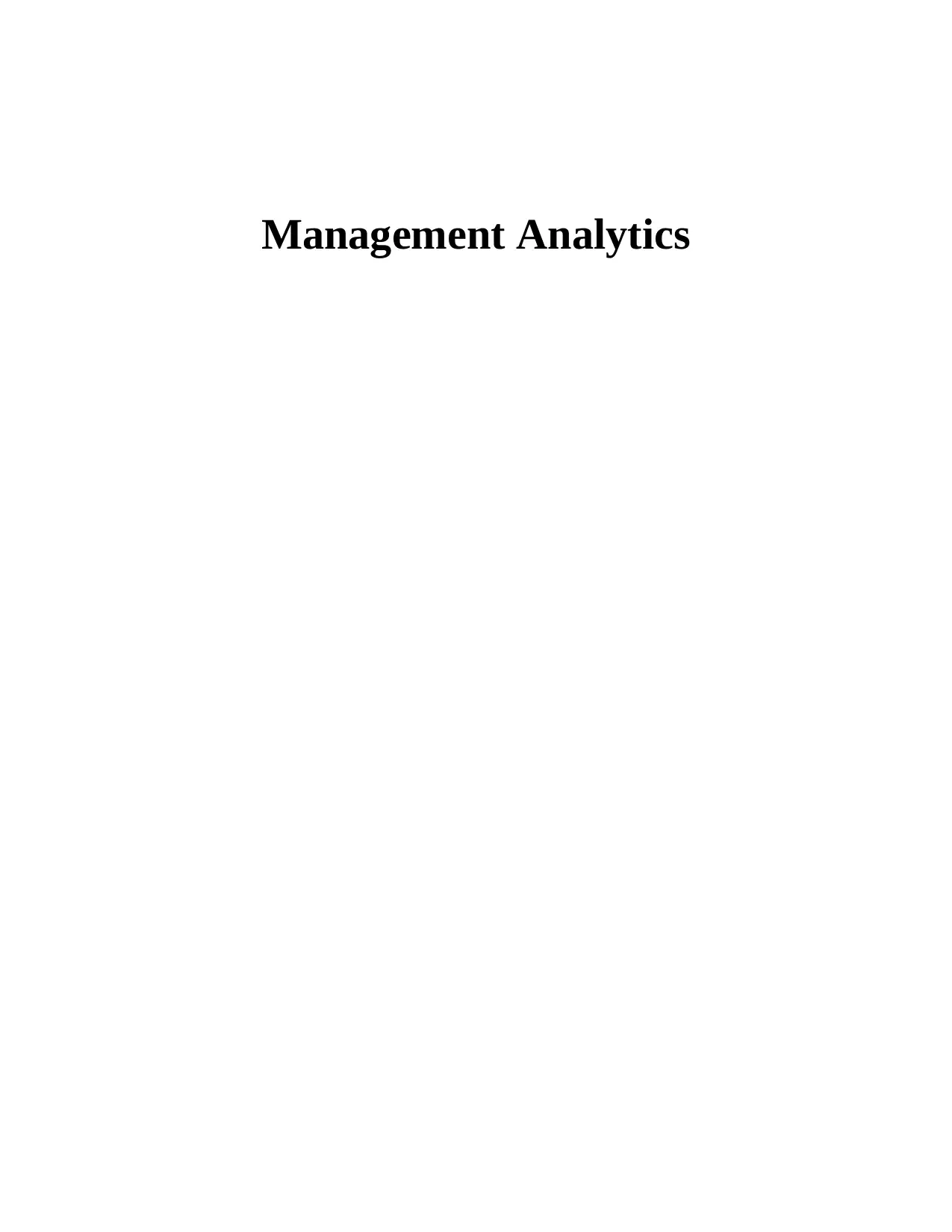
Management Analytics
Paraphrase This Document
Need a fresh take? Get an instant paraphrase of this document with our AI Paraphraser
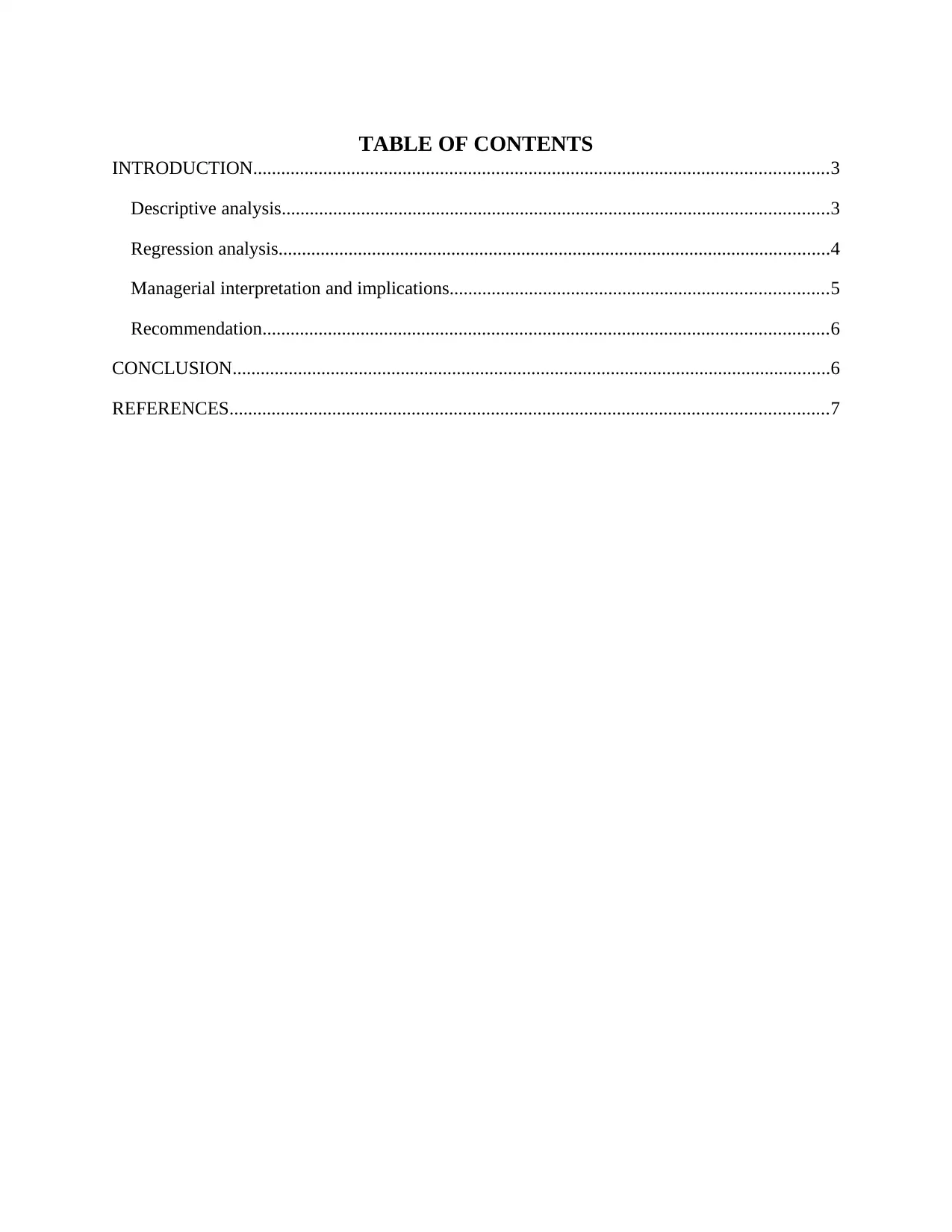
TABLE OF CONTENTS
INTRODUCTION...........................................................................................................................3
Descriptive analysis.....................................................................................................................3
Regression analysis......................................................................................................................4
Managerial interpretation and implications.................................................................................5
Recommendation.........................................................................................................................6
CONCLUSION................................................................................................................................6
REFERENCES................................................................................................................................7
INTRODUCTION...........................................................................................................................3
Descriptive analysis.....................................................................................................................3
Regression analysis......................................................................................................................4
Managerial interpretation and implications.................................................................................5
Recommendation.........................................................................................................................6
CONCLUSION................................................................................................................................6
REFERENCES................................................................................................................................7

INTRODUCTION
Management analytics involves developing a precise understanding regarding factors that
influence managerial decisions and designing data to support the managerial decision. The entire
study is based upon the fictitious data in which data regarding to gender, employee experience,
years of education, department and number supervised is mentioned. The report based upon the
research question i.e. Does there is a link between gender and wage differential? Further, with
the help of regression analysis, study will define the association between the variables and then
make recommendations which in turn assist managers or company to make effective results.
Rationale for choosing the research question: The reason behind choosing the research
question is such that there are many companies who did not pay good amount to women and
generally they have less pay as compared to men. This is considering the biggest concern
according to managerial perspective but also affected the goodwill. However, in the mid of 90’s
company did not pay enough amount to their female employees and that is why, the gender pay
gap increases which affect the brand image of a company as well. Also, in US the gender gap in
pay remain relatively stable from last 15 to 20 years but in 2020, women earned 84% of what
men earned either by full or part time working. Thus, by using relevant analytical tool, it will be
easy to determine the association between salary (dependent) and gender (independent)
variables.
Descriptive analysis
Salary Gender Department
Mean 39827.39 0.478261 2.847826
Standard
Error 1621.75 0.074465 0.181159
Median 36541.5 0 3
Mode #N/A 0 4
Standard
Deviation 10999.24 0.505047 1.228683
Sample
Variance 1.21E+08 0.255072 1.509662
Kurtosis 0.882208 -2.08455 -1.45346
Skewness 1.078567 0.090001 -0.44869
Range 45592 1 3
Management analytics involves developing a precise understanding regarding factors that
influence managerial decisions and designing data to support the managerial decision. The entire
study is based upon the fictitious data in which data regarding to gender, employee experience,
years of education, department and number supervised is mentioned. The report based upon the
research question i.e. Does there is a link between gender and wage differential? Further, with
the help of regression analysis, study will define the association between the variables and then
make recommendations which in turn assist managers or company to make effective results.
Rationale for choosing the research question: The reason behind choosing the research
question is such that there are many companies who did not pay good amount to women and
generally they have less pay as compared to men. This is considering the biggest concern
according to managerial perspective but also affected the goodwill. However, in the mid of 90’s
company did not pay enough amount to their female employees and that is why, the gender pay
gap increases which affect the brand image of a company as well. Also, in US the gender gap in
pay remain relatively stable from last 15 to 20 years but in 2020, women earned 84% of what
men earned either by full or part time working. Thus, by using relevant analytical tool, it will be
easy to determine the association between salary (dependent) and gender (independent)
variables.
Descriptive analysis
Salary Gender Department
Mean 39827.39 0.478261 2.847826
Standard
Error 1621.75 0.074465 0.181159
Median 36541.5 0 3
Mode #N/A 0 4
Standard
Deviation 10999.24 0.505047 1.228683
Sample
Variance 1.21E+08 0.255072 1.509662
Kurtosis 0.882208 -2.08455 -1.45346
Skewness 1.078567 0.090001 -0.44869
Range 45592 1 3
⊘ This is a preview!⊘
Do you want full access?
Subscribe today to unlock all pages.

Trusted by 1+ million students worldwide

Minimum 23654 0 1
Maximum 69246 1 4
Sum 1832060 22 131
Count 46 46 46
Interpretation: The descriptive statistic entails that average salary of the chosen
employees is $39827.39. In addition to this, minimum salary earned by the employees is $23654
and maximum is $69246. However, the mean of the gender is male and majority of them are
male as well. Further, majority of the chosen employees have 6 years’ experience in their
organizations and 50% of them have 4 years’ experience. Moreover, the average number of
department identified from the descriptive table is 3 and majority of the departments identified
from the table is 4. Overall, it can be stated from the interpretation that earning of employees is
high and all have enough working experience which assist employees to working in an effective
manner within their respective companies.
Regression analysis
Null Hypothesis (H0): There is no statistical association between the mean values of salary and
gender.
Alternative hypothesis (H1): There is a statistical association between the mean values of
salary and gender.
SUMMARY
OUTPUT
Regression Statistics
Multiple R
0.2486
77
R Square
0.0618
4
Adjusted R
Square
0.0405
19
Standard
Error
10774.
1
Observation
s 46
ANOVA
df SS MS F Significa
Maximum 69246 1 4
Sum 1832060 22 131
Count 46 46 46
Interpretation: The descriptive statistic entails that average salary of the chosen
employees is $39827.39. In addition to this, minimum salary earned by the employees is $23654
and maximum is $69246. However, the mean of the gender is male and majority of them are
male as well. Further, majority of the chosen employees have 6 years’ experience in their
organizations and 50% of them have 4 years’ experience. Moreover, the average number of
department identified from the descriptive table is 3 and majority of the departments identified
from the table is 4. Overall, it can be stated from the interpretation that earning of employees is
high and all have enough working experience which assist employees to working in an effective
manner within their respective companies.
Regression analysis
Null Hypothesis (H0): There is no statistical association between the mean values of salary and
gender.
Alternative hypothesis (H1): There is a statistical association between the mean values of
salary and gender.
SUMMARY
OUTPUT
Regression Statistics
Multiple R
0.2486
77
R Square
0.0618
4
Adjusted R
Square
0.0405
19
Standard
Error
10774.
1
Observation
s 46
ANOVA
df SS MS F Significa
Paraphrase This Document
Need a fresh take? Get an instant paraphrase of this document with our AI Paraphraser
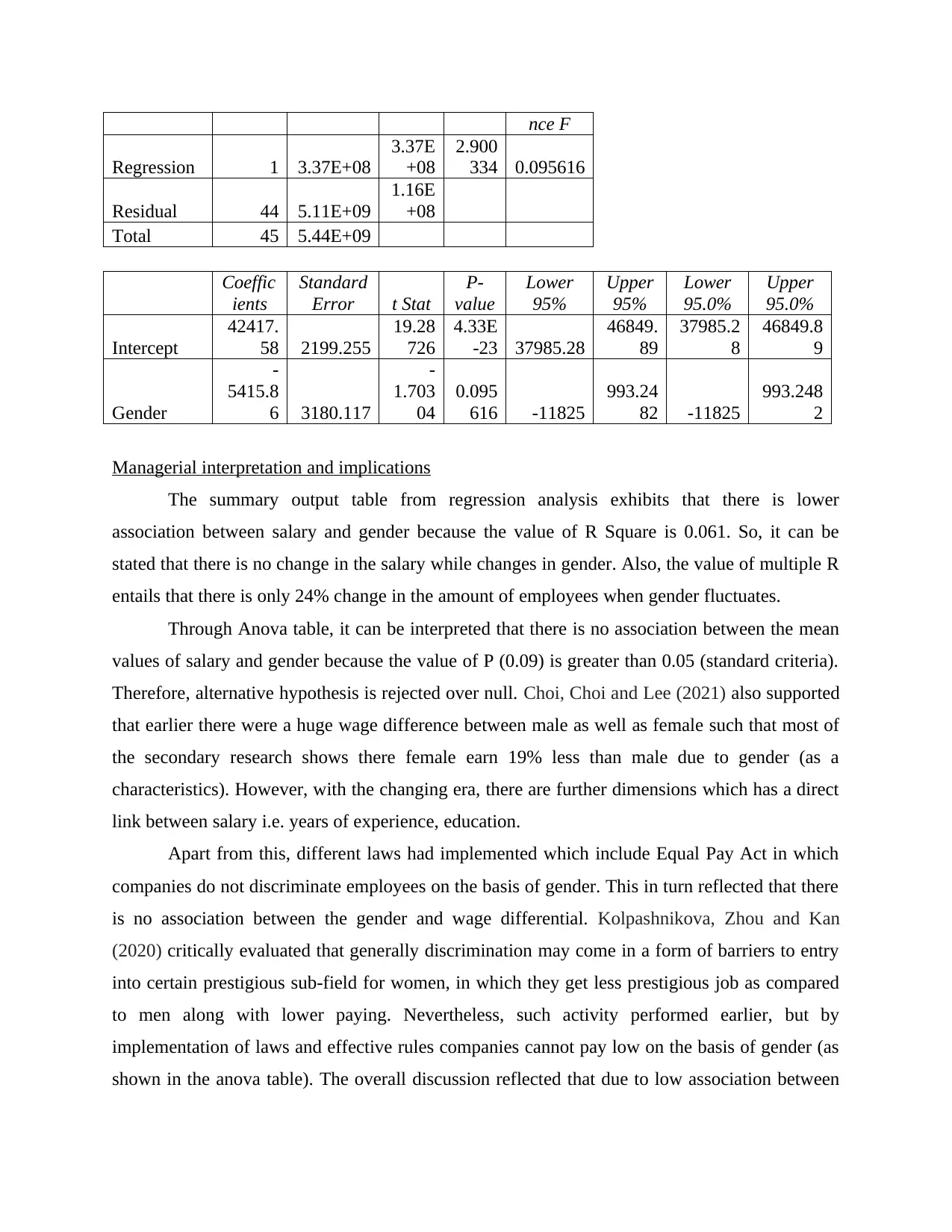
nce F
Regression 1 3.37E+08
3.37E
+08
2.900
334 0.095616
Residual 44 5.11E+09
1.16E
+08
Total 45 5.44E+09
Coeffic
ients
Standard
Error t Stat
P-
value
Lower
95%
Upper
95%
Lower
95.0%
Upper
95.0%
Intercept
42417.
58 2199.255
19.28
726
4.33E
-23 37985.28
46849.
89
37985.2
8
46849.8
9
Gender
-
5415.8
6 3180.117
-
1.703
04
0.095
616 -11825
993.24
82 -11825
993.248
2
Managerial interpretation and implications
The summary output table from regression analysis exhibits that there is lower
association between salary and gender because the value of R Square is 0.061. So, it can be
stated that there is no change in the salary while changes in gender. Also, the value of multiple R
entails that there is only 24% change in the amount of employees when gender fluctuates.
Through Anova table, it can be interpreted that there is no association between the mean
values of salary and gender because the value of P (0.09) is greater than 0.05 (standard criteria).
Therefore, alternative hypothesis is rejected over null. Choi, Choi and Lee (2021) also supported
that earlier there were a huge wage difference between male as well as female such that most of
the secondary research shows there female earn 19% less than male due to gender (as a
characteristics). However, with the changing era, there are further dimensions which has a direct
link between salary i.e. years of experience, education.
Apart from this, different laws had implemented which include Equal Pay Act in which
companies do not discriminate employees on the basis of gender. This in turn reflected that there
is no association between the gender and wage differential. Kolpashnikova, Zhou and Kan
(2020) critically evaluated that generally discrimination may come in a form of barriers to entry
into certain prestigious sub-field for women, in which they get less prestigious job as compared
to men along with lower paying. Nevertheless, such activity performed earlier, but by
implementation of laws and effective rules companies cannot pay low on the basis of gender (as
shown in the anova table). The overall discussion reflected that due to low association between
Regression 1 3.37E+08
3.37E
+08
2.900
334 0.095616
Residual 44 5.11E+09
1.16E
+08
Total 45 5.44E+09
Coeffic
ients
Standard
Error t Stat
P-
value
Lower
95%
Upper
95%
Lower
95.0%
Upper
95.0%
Intercept
42417.
58 2199.255
19.28
726
4.33E
-23 37985.28
46849.
89
37985.2
8
46849.8
9
Gender
-
5415.8
6 3180.117
-
1.703
04
0.095
616 -11825
993.24
82 -11825
993.248
2
Managerial interpretation and implications
The summary output table from regression analysis exhibits that there is lower
association between salary and gender because the value of R Square is 0.061. So, it can be
stated that there is no change in the salary while changes in gender. Also, the value of multiple R
entails that there is only 24% change in the amount of employees when gender fluctuates.
Through Anova table, it can be interpreted that there is no association between the mean
values of salary and gender because the value of P (0.09) is greater than 0.05 (standard criteria).
Therefore, alternative hypothesis is rejected over null. Choi, Choi and Lee (2021) also supported
that earlier there were a huge wage difference between male as well as female such that most of
the secondary research shows there female earn 19% less than male due to gender (as a
characteristics). However, with the changing era, there are further dimensions which has a direct
link between salary i.e. years of experience, education.
Apart from this, different laws had implemented which include Equal Pay Act in which
companies do not discriminate employees on the basis of gender. This in turn reflected that there
is no association between the gender and wage differential. Kolpashnikova, Zhou and Kan
(2020) critically evaluated that generally discrimination may come in a form of barriers to entry
into certain prestigious sub-field for women, in which they get less prestigious job as compared
to men along with lower paying. Nevertheless, such activity performed earlier, but by
implementation of laws and effective rules companies cannot pay low on the basis of gender (as
shown in the anova table). The overall discussion reflected that due to low association between
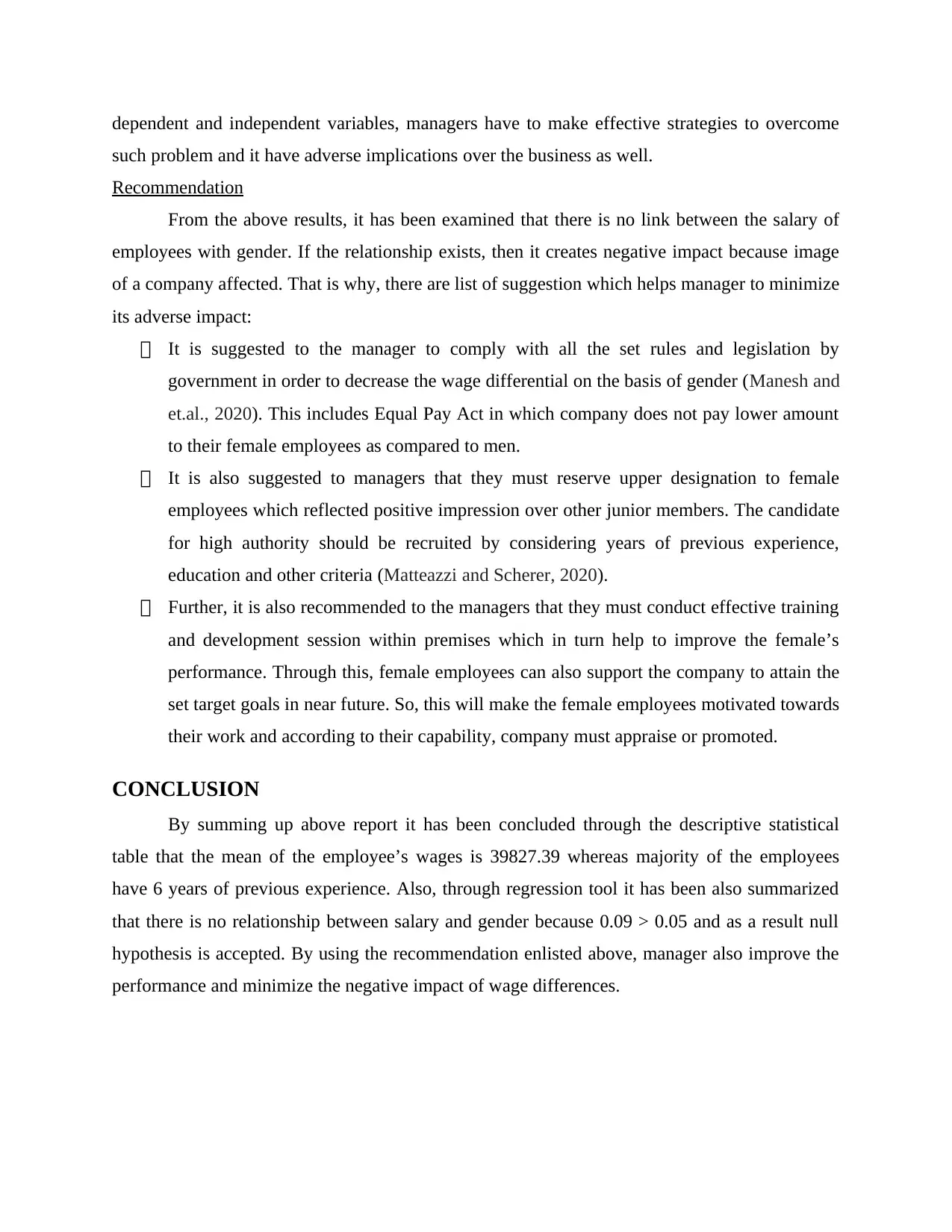
dependent and independent variables, managers have to make effective strategies to overcome
such problem and it have adverse implications over the business as well.
Recommendation
From the above results, it has been examined that there is no link between the salary of
employees with gender. If the relationship exists, then it creates negative impact because image
of a company affected. That is why, there are list of suggestion which helps manager to minimize
its adverse impact:
It is suggested to the manager to comply with all the set rules and legislation by
government in order to decrease the wage differential on the basis of gender (Manesh and
et.al., 2020). This includes Equal Pay Act in which company does not pay lower amount
to their female employees as compared to men.
It is also suggested to managers that they must reserve upper designation to female
employees which reflected positive impression over other junior members. The candidate
for high authority should be recruited by considering years of previous experience,
education and other criteria (Matteazzi and Scherer, 2020).
Further, it is also recommended to the managers that they must conduct effective training
and development session within premises which in turn help to improve the female’s
performance. Through this, female employees can also support the company to attain the
set target goals in near future. So, this will make the female employees motivated towards
their work and according to their capability, company must appraise or promoted.
CONCLUSION
By summing up above report it has been concluded through the descriptive statistical
table that the mean of the employee’s wages is 39827.39 whereas majority of the employees
have 6 years of previous experience. Also, through regression tool it has been also summarized
that there is no relationship between salary and gender because 0.09 > 0.05 and as a result null
hypothesis is accepted. By using the recommendation enlisted above, manager also improve the
performance and minimize the negative impact of wage differences.
such problem and it have adverse implications over the business as well.
Recommendation
From the above results, it has been examined that there is no link between the salary of
employees with gender. If the relationship exists, then it creates negative impact because image
of a company affected. That is why, there are list of suggestion which helps manager to minimize
its adverse impact:
It is suggested to the manager to comply with all the set rules and legislation by
government in order to decrease the wage differential on the basis of gender (Manesh and
et.al., 2020). This includes Equal Pay Act in which company does not pay lower amount
to their female employees as compared to men.
It is also suggested to managers that they must reserve upper designation to female
employees which reflected positive impression over other junior members. The candidate
for high authority should be recruited by considering years of previous experience,
education and other criteria (Matteazzi and Scherer, 2020).
Further, it is also recommended to the managers that they must conduct effective training
and development session within premises which in turn help to improve the female’s
performance. Through this, female employees can also support the company to attain the
set target goals in near future. So, this will make the female employees motivated towards
their work and according to their capability, company must appraise or promoted.
CONCLUSION
By summing up above report it has been concluded through the descriptive statistical
table that the mean of the employee’s wages is 39827.39 whereas majority of the employees
have 6 years of previous experience. Also, through regression tool it has been also summarized
that there is no relationship between salary and gender because 0.09 > 0.05 and as a result null
hypothesis is accepted. By using the recommendation enlisted above, manager also improve the
performance and minimize the negative impact of wage differences.
⊘ This is a preview!⊘
Do you want full access?
Subscribe today to unlock all pages.

Trusted by 1+ million students worldwide
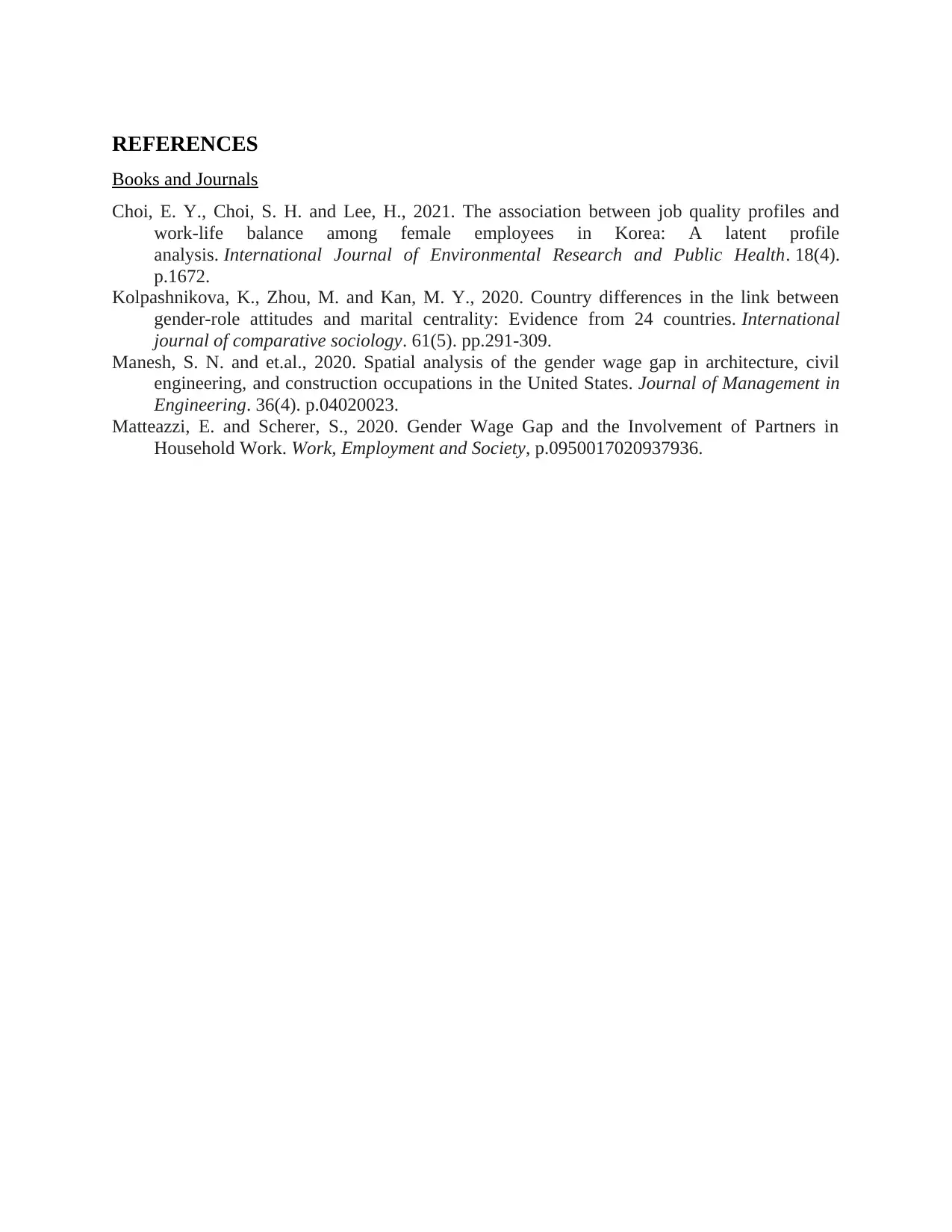
REFERENCES
Books and Journals
Choi, E. Y., Choi, S. H. and Lee, H., 2021. The association between job quality profiles and
work-life balance among female employees in Korea: A latent profile
analysis. International Journal of Environmental Research and Public Health. 18(4).
p.1672.
Kolpashnikova, K., Zhou, M. and Kan, M. Y., 2020. Country differences in the link between
gender-role attitudes and marital centrality: Evidence from 24 countries. International
journal of comparative sociology. 61(5). pp.291-309.
Manesh, S. N. and et.al., 2020. Spatial analysis of the gender wage gap in architecture, civil
engineering, and construction occupations in the United States. Journal of Management in
Engineering. 36(4). p.04020023.
Matteazzi, E. and Scherer, S., 2020. Gender Wage Gap and the Involvement of Partners in
Household Work. Work, Employment and Society, p.0950017020937936.
Books and Journals
Choi, E. Y., Choi, S. H. and Lee, H., 2021. The association between job quality profiles and
work-life balance among female employees in Korea: A latent profile
analysis. International Journal of Environmental Research and Public Health. 18(4).
p.1672.
Kolpashnikova, K., Zhou, M. and Kan, M. Y., 2020. Country differences in the link between
gender-role attitudes and marital centrality: Evidence from 24 countries. International
journal of comparative sociology. 61(5). pp.291-309.
Manesh, S. N. and et.al., 2020. Spatial analysis of the gender wage gap in architecture, civil
engineering, and construction occupations in the United States. Journal of Management in
Engineering. 36(4). p.04020023.
Matteazzi, E. and Scherer, S., 2020. Gender Wage Gap and the Involvement of Partners in
Household Work. Work, Employment and Society, p.0950017020937936.
1 out of 7
Related Documents
Your All-in-One AI-Powered Toolkit for Academic Success.
+13062052269
info@desklib.com
Available 24*7 on WhatsApp / Email
![[object Object]](/_next/static/media/star-bottom.7253800d.svg)
Unlock your academic potential
Copyright © 2020–2025 A2Z Services. All Rights Reserved. Developed and managed by ZUCOL.




